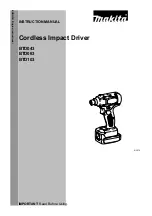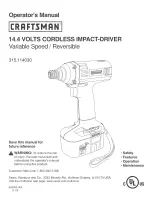
17
16
M12 FQID
..................... 4696 85 02...
...000001-999999
.........................1/4" (6 mm) HEX
....................0-1100 min
-1
......................0-950 min
-1
........................ M14
....................0-2200 min
-1
....................0-2200 min
-1
........................ M14
....................0-3200 min
-1
....................0-3400 min
-1
........................ M14
....................0-3200 min
-1
....................0-3400 min
-1
........................ M14
........................50.8 Nm
...........................12 V
............. 1,1 kg / 1,3 kg
..................... -18...+50 °C
......................... M12B...
M12-18 C; M12-18 FC; M12-18 AC; M12 C4; C12 C
......................84,07 dB (A)
......................95,07 dB (A)
......................12,79 m/s
2
..........................1,5 m/s
2
• Fastening position – Holding the tool or the driving fastener in
various angles will aff ect the torque.
• Drive accessory/socket – Failure to use the correct size
accessory or socket, or a non-impact rated accessory may
cause a reduction in the fastening torque.
• Use of accessories and extensions – Depending on the
accessory or extension fi tment can reduce the fastening force
of the impact driver.
• Bolt/Nut – Fastening torques may diff er according to the
diameter of the nut or bolt, the class of nut/bolt and the length
of nut/bolt.
• Condition of the fastener – Contaminated, corroded, dry or
lubricated fasteners may vary the fastening torques.
• Condition and base material – The base material of the
fastener and any component in between the surfaces may
eff ect the fastening torque (Dry or lubricated base, soft or
hard base, disc, seal or washer between fastener and base
material).
BATTERIES
Battery packs which have not been used for some time should
be recharged before use.
Temperatures in excess of 50°C (122°F) reduce the
performance of the battery pack. Avoid extended exposure to
heat or sunshine (risk of overheating).
The contacts of chargers and battery packs must be kept clean.
For an optimum life-time, after use, the battery packs have to
be fully charged.
To obtain the longest possible battery life remove the battery
pack from the charger once it is fully charged.
For battery pack storage longer than 30 days:
Store the battery pack where the temperature is below 27°C
and away from moisture
Store the battery packs in a 30% - 50% charged condition
Every six months of storage, charge the pack as normal.
BATTERY PACK PROTECTION
In extremely high torque, binding, stalling and short circuit
situations that cause high current draw, the tool will vibrate for
about 2 seconds and then the tool will turn OFF.
To reset, release the trigger.
Under extreme circumstances, the internal temperatur of the
battery could become to high. If this happens, the battery will
shut down.
Place the battery on the charger to charge and reset it.
TRANSPORTING LITHIUM BATTERIES
Lithium-ion batteries are subject to the Dangerous Goods
Legislation requirements.
Transportation of those batteries has to be done in accordance
with local, national and international provisions and regulations.
• The user can transport the batteries by road without further
requirements.
• Commercial transport of Lithium-Ion batteries by third parties
is subject to Dangerous Goods regulations. Transport
preparation and transport are exclusively to be carried out by
appropriately trained persons and the process has to be
accompanied by corresponding experts.
When transporting batteries:
• Ensure that battery contact terminals are protected and
insulated to prevent short circuit.
• Ensure that battery pack is secured against movement within
packaging.
• Do not transport batteries that are cracked or leak.
Check with forwarding company for further advice
MAINTENANCE
Use only Milwaukee accessories and spare parts. Should
components need to be replaced which have not been
described, please contact one of our Milwaukee service agents
(see our list of guarantee/service addresses).
If needed, an exploded view of the tool can be ordered. Please
state the machine type printed as well as the six-digit No. on
the label and order the drawing at your local service agents or
directly at: Techtronic Industries GmbH, Max-Eyth-Straße 10,
71364 Winnenden, Germany.
SYMBOLS
CAUTION! WARNING! DANGER!
Remove the battery pack before starting any
work on the machine.
Please read the instructions carefully before
starting the machine.
Do not dispose electric tools, batteries/rechargeable
batteries together with household waste material.
Electric tools and batteries that have reached the end
of their life must be collected separately and returned
to an environmentally compatible recycling facility.
Check with your local authority or retailer for recycling
advice and collection point.
n
0
No-load speed
n
Impact range
V
Volts
Direct current
European Conformity Mark
British Confomity Mark
Ukraine Conformity Mark
EurAsian Conformity Mark
TECHNISCHE DATEN
AKKU-SCHLAGSCHRAUBER
Produktionsnummer ...............................................................
Werkzeugaufnahme ...............................................................
Leerlaufdrehzahl ........................................................
Schlagzahl .................................................................
Maximale Schraubengröße / Mutterngröße ...............
Leerlaufdrehzahl ........................................................
Schlagzahl .................................................................
Maximale Schraubengröße / Mutterngröße ...............
Leerlaufdrehzahl ........................................................
Schlagzahl .................................................................
Maximale Schraubengröße / Mutterngröße ...............
Leerlaufdrehzahl ........................................................
Schlagzahl .................................................................
Maximale Schraubengröße / Mutterngröße ...............
Max. Anzugsmoment ..............................................................
Spannung Wechselakku .........................................................
Gewicht nach EPTA-Prozedur 01/2014
(2,0 Ah / 4,0 Ah)
.......
Empfohlene Umgebungstemperatur beim Arbeiten................
Empfohlene Akkutypen ...........................................................
Empfohlene Ladegeräte .........................................................
Geräusch/Vibrationsinformation
Messwerte ermittelt entsprechend EN 62841.
Der A-bewertete Geräuschpegel des Gerätes beträgt
typischerweise:
Schalldruckpegel (Unsicherheit K=3dB(A)) ............................
Schallleistungspegel (Unsicherheit K=3dB(A)) .......................
Gehörschutz tragen!
Schwingungsgesamtwerte (Vektorsumme dreier Richtungen)
ermittelt entsprechend EN 62841.
Schwingungsemissionswert a
h
Anziehen von Schrauben und Muttern maximaler Größe ...
Unsicherheit K= ...................................................................
WARNUNG! Lesen Sie alle Sicherheitshinweise,
Anweisungen, Darstellungen und Spezifi kationen für
dieses Elektrowerkzeug.
Versäumnisse bei der Einhaltung
der nachstehenden Anweisungen können elektrischen Schlag,
Brand und/oder schwere Verletzungen verursachen.
Bewahren Sie alle Sicherheitshinweise und Anweisungen
für die Zukunft auf.
SICHERHEITSHINWEISE FÜR SCHLAGSCHRAUBER
Halten Sie das Gerät an den isolierten Griff fl ächen, wenn
Sie Arbeiten ausführen, bei denen die Schraube
verborgene Stromleitungen treff en kann.
Der Kontakt der
Schraube mit einer spannungsführenden Leitung kann
metallene Geräteteile unter Spannung setzen und zu einem
elektrischen Schlag führen.
Tragen Sie Gehörschutz.
Die Einwirkung von Lärm kann
Gehörverlust bewirken.
DEUTSCH
WEITERE SICHERHEITS- UND ARBEITSHINWEISE
Schutzausrüstung verwenden. Beim Arbeiten mit der Maschine
stets Schutzbrille tragen. Schutzkleidung wie
Staubschutzmaske, Schutzhandschuhe, festes und
rutschsicheres Schuhwerk, Helm und Gehörschutz werden
empfohlen.
Beim Arbeiten entstehender Staub ist oft gesundheitsschädlich
und sollte nicht in den Körper gelangen. Geeignete
Staubschutzmaske tragen.
Es dürfen keine Materialien bearbeitet werden, von denen eine
Gesundheitsgefährdung ausgeht (z.B. Asbest).
Beim Blockieren des Einsatzwerkzeuges bitte das Gerät sofort
ausschalten! Schalten Sie das Gerät nicht wieder ein, solange
das Einsatzwerkzeug blockiert ist; hierbei könnte ein
WARNUNG!
Die angegebenen Schwingungsgesamtwerte und Geräuschemissionswerte wurden nach einem genormten Messverfahren gemäß
EN 62841 gemessen und können für den Vergleich von Elektrowerkzeugen miteinander verwendet werden. Es kann für eine
vorläufi ge Einschätzung der Belastung verwendet werden.
Der angegebene Schwingungs- und Geräuschemissionspegel repräsentiert die hauptsächlichen Anwendungen des
Elektrowerkzeugs. Wenn allerdings das Elektrowerkzeug für andere Anwendungen, mit abweichenden Einsatzwerkzeugen oder
ungenügender Wartung eingesetzt wird, können sich die Schwingungs- und Geräuschemissionen unterscheiden. Dies kann deren
Wirkung über den gesamten Arbeitszeitraum deutlich erhöhen.
Bei der Abschätzung der Belastung durch Schwingungen und Lärm sollten auch die Zeiten berücksichtigt werden, in denen das
Elektrowerkzeug ausgeschaltet ist oder zwar läuft, aber keine tatsächliche Arbeit verrichtet wird. Dies kann deren Wirkung über den
gesamten Arbeitszeitraum deutlich reduzieren.
Legen Sie zusätzliche Sicherheitsmaßnahmen zum Schutz des Bedieners vor den Auswirkungen von Schwingungen- und / oder
Lärm fest, wie z. B.: Wartung des Werkzeugs und des Zubehörs, Warmhalten der Hände, Organisation der Arbeitsabläufe.
ENGLISH










































